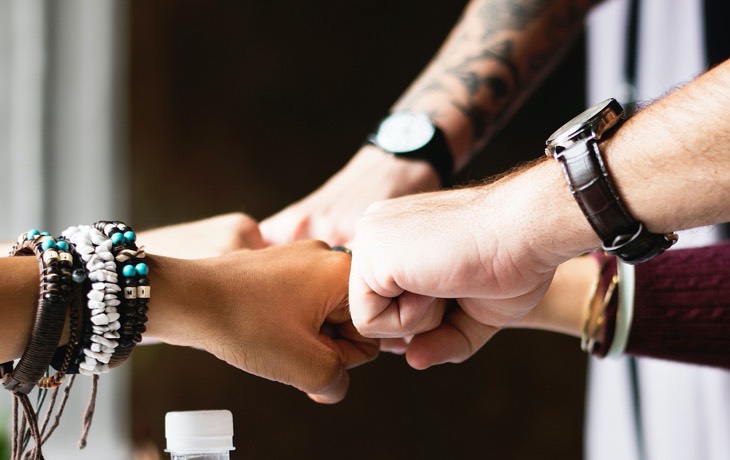There’s a kind of all-or-nothing fatalism I’ve seen take hold in some people, which goes something like: “if I can’t isolate myself entirely, then I’m just going to get infected anyway, so what’s the point in doing anything different?”
This is wrong. Don’t be like this, because social isolation and “flattening the curve” aren’t solely about locking down completely and cutting off all social contact.
Even if you’re not ready to go Full Turtle, you can do your part to protect yourself and help society beat COVID-19 by:
- Taking multiple small steps that together add up to lower your chance of infection and lower the overall rate of spread through communities.
- Recognizing that every new day is riskier than the previous one.
Small steps add up
Managing infection risk doesn’t have to be about going down into a bunker and closing the hatch (although if you can reasonably do that and are at-risk for serious illness, now’s not a bad time).
Rather, each small action that reduces your odds of infection just a little bit — standing further away from people, obsessively washing your hands, choosing to avoid crowds and limiting yourself to small gatherings and one-on-one encounters — adds together to give you a big reduction in personal risk.
To really get your mind around how this works, think about all the little things you do to manage risk when driving a car: wear a seatbelt, use a turn signal, drive the speed limit, don’t drink or text and drive, have your brakes checked regularly, etc. Each of these things helps a little, and when done together they all add up to a dramatically safer driving experience — both for you and those you share the road with — than if you didn’t do any of them at all.
Approach social distancing the way you approach car safety: not as a single binary decision to go Full Turtle and shelter in place, but as a collection of little risk-reducing behaviors that add up to a big win.
Right now and in the near term, every day brings more risk
The number of SARS-COV-2 infections is rising by the day, and you can probably assume it’s in your area by now. The number of local cases are likely doubling every six days or less.
That means your risk from being around the same-sized crowd of people doubles every six days, as well.
Given this mathematical reality, you should respond in three important ways:
- Quickly and progressively reduce the size of the crowds you’re exposed to. That may mean taking off work to go to the store for supplies at an odd hour, or even getting out of a densely populated area. Every single day it gets more important that you be around even fewer people than yesterday.
- Ramp up your use of personal protective equipment in a reasonable way. You don’t need to go full hazmat just to fill your gas tank, but you could easily wear gloves. If you’re elderly or otherwise at-risk, it’s reasonable to start wearing face protection in addition to gloves if you have to go to a crowded place and you know the virus is already in your community.
- Take on progressively more social and reputational risk in order to reduce your physical risk. eg. If you’re working a retail counter tomorrow and an obviously ill customer approaches you, discretely excuse yourself for the restroom at the risk of having that person try to get you fired. You might want to start using sick days next week. Get bold and creative with how to distance yourself in-the-moment, and be more willing to offend people as this progresses.
An example from my household
Here’s how the above advice looked at my house this morning, the day that was supposed to be the start of our total lockdown, but that didn’t quite happen.
This morning when I got up, I crudely estimated that in my town just north of Austin, there are currently relatively few COVID-19 cases. I based this back-of-the-envelope estimation on the smallish size of the population, the lack of any talk in local groups of infections or mounting ICU waits, and on the very low emergent care facility wait times advertised on local billboards.
Is my sense of the case load here scientific? No, of course not. I’m just doing my best with what I have, and trying to make sensible decisions in the moment.
My wife and I apparently had a miscommunication on Wednesday, when she asked me if she should cancel all her clients on Friday (she’s a therapist), and I thought I’d said yes but she thought I said “I don’t know.”
So she had booked eight client sessions for today. Neither of us was happy about this, so we had our first decision to make: cancel all these people at the last minute and put them in a bind, or go ahead with it.
We figured that right now, a “crowd size” of eight is an acceptable risk, and that she’d take the following further risk mitigation measures at the office:
- Send away any client who gives even a hint of a whiff of being ill, no matter how much it offends them. If anyone so much as clears their throat, then no session for them.
- Copious use of hand sanitizer, and wiping down surfaces in between sessions.
- Sitting unusually far away from all clients in the office.
- Coming straight home afterwards, with no stops for any reason.
Neither of us are thrilled with the measures above, but we weighed the odds as best we could and came up with a list of mitigation measures that will work together to reduce infection risk. It’s not perfect, but we hope and pray it’s good enough to do the job.
As for me, I went to Walmart for some last-minute stocking up. It wasn’t crowded, and I wore gloves, a mask, and dark sunshades. Obviously, the sunshades aren’t adequate as eye protection, but I took the risk because Walmart was not at all crowded and I wanted to get a sense of people’s reaction to me from behind the shades.
(For the curious, the shelves were almost bare, and only two people obviously looked at me like I was nuts. I wasn’t the only one wearing personal protective equipment, either.)
I hope this post helps someone who’s struggling with not being able to do a total lockdown. As you can see from my account of my own morning, despite being ready we still haven’t yet fully isolated ourselves on our property. (Though the kids are home from school, and were looked after this morning by a close friend who’s stying with us for the duration.) As of today, we were still weighing the odds and doing our best to reduce risk without yet eliminating it entirely.
So even if you can’t go full doomsday bunker, it’s not at all hopeless. You just have to do your best to assess the odds in your area, and then take whatever measures you can muster at the moment. Be a little more willing than usual to embarrass yourself or someone else in the name of safety, and in general be prepared to do things socially you wouldn’t normally do.
If you can manage just that little bit, you can make a real dent in your odds of infection. And not only will this help keep you safe, but it’ll keep you from infecting others and it’ll help free up hospital beds for the most critical cases. #FlattenTheCurve


You are reporting the comment """ by on